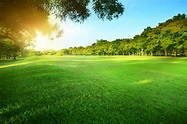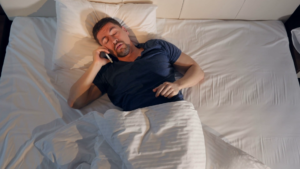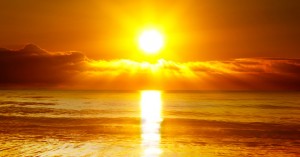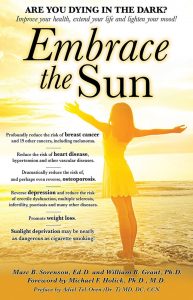Sunshine and Greenspace, by Marc Sorenson, EdD.
A part of my life, albeit I did not fully savor nor appreciate them.
Sunshine and greenspace should  be loved by all. Greenspace is an area of grass, trees, or other vegetation set apart for recreational or aesthetic purposes. In my case, there was not much winter participation outdoors and there was not much green. There was school study inside, snow and ice outside and not much greenery. Thus, thus colds and other irritating illnesses ruled my life. In summers, I spent my life on our ranch, working hay fields, chasing cattle bare-chested and doing other sundry chores. In addition, “green” was all around me in summer, since green fields of alfalfa corn and grass were ubiquitous. Consequently, my health was perfect! Of course, because of the Sunshine that blazed much of the day, there were other benefits. I was the recipient of nitric oxide, dopamine, circadian-rhythm entrainment, serotonin, endorphin, BDNF and vitamin D. King Kong could not have felt much better than I felt.
be loved by all. Greenspace is an area of grass, trees, or other vegetation set apart for recreational or aesthetic purposes. In my case, there was not much winter participation outdoors and there was not much green. There was school study inside, snow and ice outside and not much greenery. Thus, thus colds and other irritating illnesses ruled my life. In summers, I spent my life on our ranch, working hay fields, chasing cattle bare-chested and doing other sundry chores. In addition, “green” was all around me in summer, since green fields of alfalfa corn and grass were ubiquitous. Consequently, my health was perfect! Of course, because of the Sunshine that blazed much of the day, there were other benefits. I was the recipient of nitric oxide, dopamine, circadian-rhythm entrainment, serotonin, endorphin, BDNF and vitamin D. King Kong could not have felt much better than I felt.
It is apodictic that my good feelings and perfect physical rhythms were due to sunshine and greenspace. Yet, I believe I could have chosen to be outside more in the winter.
My parents raised me on the Utah/Nevada border. Hence, there was plenty of snow, but also plenty of sun in the winter. The nearby mountains and evergreen forests furnished a lot of green year-round. UVA light, lacking in the capacity to produce vitamin D, produces nitric oxide, serotonin and helps to reset the circadian rhythms. It might have enhanced my dark mood in winter. Nevertheless, due to my distaste of cold weather, I stayed inside to study and spent time in the gym.
It was not until much later that I learned the value of sunshine and greenspace.
Now it seems like there are a plethora of studies that praise the value of greenspace. I added the word “sunshine” in this paper because of my belief that majority of the benefits occur due to sunlight. The most eye opening and impressive of those studies is one called, The Health Benefits of the Great Outdoors. A Systematic Review and Meta-Analysis of Greenspace Exposure and Health Outcomes. It was a meta-analysis (highly respected and statistically believable). In addition, it used data from 103 observational and 40 interventional studies. It also measured 100 different health outcomes for people who participated (or did not) in greenspace areas and activities.
The remarkable results and health benefits of the great outdoors.
Here are the highly impressive and significant results of increased greenspace exposure.
Greenspaces associated with reduced risk of the following measurements:
- Salivary cortisol (the body’s main stress hormone).
- heart rate (-2.7 bpm)
- diastolic blood pressure (-1.97)
- HDL cholesterol (-.003)
- Low-frequency heart rate variability (-.06)
- pre-term birth (-13)
- type II diabetes (-.28)
- All-cause mortality (-.31)
- Small size for gestational age (-.19)
- Cardiovascular mortality (-.16)
In addition, there was an increased incidence of good self-reported health.
The researchers also reported, “The incidence of stroke, hypertension, dyslipidaemia, asthma, and coronary heart disease were reduced.” “For several non-pooled health outcomes, between 66.7% and 100% of studies showed health-denoting associations with increased greenspace exposure including neurological and cancer-related outcomes, and respiratory mortality.”
Save the Children!
In conclusion, one recent study on children shows that mental health problems, addiction, and neurotic or stress related disorders reduced between 40-50%. This same study showed that greenspace appeared to lower the risk of personality disorders, bipolar and mood disorders, and schizophrenia.
The message of course, is to get outdoors where it is green. Then, sunshine and greenspace can work together for wonderful health benefits.
For the research on the magnificent health affects of regular, non-burning sun exposure, visit sunlightinstitute.org and read the book Embrace the Sun, by Sorenson and Grant.
The phone, sunlight and sound sleep. By Marc Sorenson, EdD. 
The phone is ubiquitous, and it may be taking away a basic human need: sound and restful sleep.
How should the sleep/wake cycle work?
First of all, we awake to bright sunshine. Light enters the eye and stimulates serotonin production. Serotonin is a natural “upper” and mood elevator. Thus, we quickly become awake and invigorated. The bright sunshine also suppresses melatonin, the sleep inducer. Yet at evening light disappears (at least that is how nature intended it), melatonin levels rise, and serotonin levels diminish. We begin to feel sleepy and ideally retire for a good night’s rest. It is a perfect system for our needs—unless we stay up beyond biologically natural hours by using artificial lighting.
Then, the phone throws a wrench into the works!
Particularly, a phone, tablet, computer monitor and other electronic device that emits blue light can interfere with sleep cycles. This may leave you wide-awake and staring at the ceiling when you should be sleeping peacefully. Furthermore, you may feel “out of sync” the next day due to lack of rest. We hear a plethora of advice about using blue-blocker screens, and heaven forbid, giving up the devices at night! Regrettably, however, some humans would rather die than not check their devices just before, and many times during, bedtime. Perhaps they are incorrigibly addicted to the phone, tablet, etc. In addition, such activities inhibit melatonin secretion. Best to eschew the phone by night and embrace the sun by day!
So, is there any way to cater to our phone addictions and still get some shut-eye?
An interesting study showed that exposure to constant bright light, for several hours daily, stopped sleeplessness and let melatonin dominate at night. The researchers compared subjects reading a book (no blue light) and a tablet (lots of blue light). They also assessed sleep patterns and melatonin concentrations. Both groups had identical results for melatonin and sleep patterns. From this research, it appears that we can have our cake and eat it too, provided we receive plenty of sunlight. Most noteworthy was that it was not lack of blue light (when the devices were removed) that enhanced sleep. Rather, it was the bright light exposure in the day. Hence, we can evade sleep-deprivation punishment for  excessive device use if we take our time in the sunlight!
excessive device use if we take our time in the sunlight!
So is there other research indicative of the night-time-sleep-inducing effects of daytime sun exposure?
There are several. For a full discussion, I suggest you read my book, Embrace the Sun, co-authored by Dr. William Grant.
Another investigation established that people whose workplaces have windows are able to sleep about 46 minutes per night longer on average, than those who have no natural light access. Those with windows also are generally happier, have fewer ailments, and experience better vitality than their window-less counterparts.
Why is sleep so important to health, regardless of cell phone, sunlight, etc.?
Another article shows that too little sleep can be deadly. Forbes Magazine online printed an excellent article on sunlight and sleep, which listed the following horrendous statistics: “In 2012, 60 million Americans filled prescriptions for sleeping pills, up from 46 million in 2006.” The article discusses the potential dangers of sleep medications, showing that those who take 18 sleeping pills per year have a tripling of the risk of death compared to those who take fewer than 18.
Do not expect the drug companies to be touting these stats. Take matters in your own hands and get some daily, non-burning sun exposure. In addition, read Embrace the Sun,
Nearly every article written on the addictive influences of sun exposure or other UV exposure takes a negative tack. We need to realize that some addictions are very good for us. Some runners are addicted to getting up every morning and going on the morning run. If one wants to be slim and fit, that is certainly a positive addiction. Hugging my wife is also a positive addiction; her touch helps to heal me and fills me with an addictive love. I’m also addicted to hiking in the pines and aspens near my Nevada ranch. There is little more exhilarating than being at 11,000 feet elevation and breathing the clear mountain air during a hike. You probably have your own positive addictions.
Sun exposure can certainly become an addiction, but is that all bad? In my opinion, no. When done habitually, sunning reduces the risk of melanoma and reduced the risk of myriad harmful diseases. It is therefore a positive and salubrious addiction.
A recent study, somewhat negative in tone, demonstrates that UVB light, contained in both sun lamp radiation and sun radiation, triggers the production of beta endorphins, one of the feel-good chemicals, sometimes called a “reward” chemical, that makes us want more.[i] The researchers used 12 healthy volunteers and used a UVB lamp to deliver a dose of narrow-band UVB light. Skin samples were taken before and after the exposure. After 24 hours, the skin samples showed an increase in endorphin levels in 11 of the twelve subjects.
Sun exposure enhances health. A twenty-year study demonstrated that the risk of death among people who were sun-seekers was only half that of those who received little sun.[ii] The researchers made this statement: “In both models the summary sun exposure variables showed a ‘dose-dependent’ inverse relation between sun exposure and all-cause death.”
Obviously, habitual sun exposure produces a positive addiction, and that is good! God (or nature if you prefer) has programmed our bodies to seek the sunlight in order to help provide a healthful and rewarding life. “Habitual” is the operative word here. An occasional blast of sun that causes burning is definitely not recommended. Be careful and enjoy your positive addictions.
[i] Jussila A, Huotari-Orava R, Ylianttila L, Partonen T, Snellman E. Narrow-band ultraviolet B radiation induces the expression of β-endorphin in human skin in vivo. J Photochem Photobiol B. 2016 Feb;155:104-8.
[ii] Pelle G. Lindqvist, Elisabeth Epstein, Mona Landin-Olsson, Christian Ingvar, Kari Nielsen, Magnus Stenbeck & Håkan Olsson. Avoidance of sun exposure is a risk factor for all-cause mortality: results from the Melanoma in Southern Sweden cohort. J Intern Med. 2014 Jul;276(1):77-86.
By Marc Sorenson, EdD, Sunlight Institute
Sometimes we come across research, conducted many years ago, that carries a great message of health for those who seek the sun. In this case the research was done in 1988 and involved a study on mice that were given a chemical protocol designed to induce skin cancer.[1] Half of the mice were also given ultraviolet B (UVB) irradiation during that protocol. After 20 weeks of cancer a cancer initiation-promotion protocol with two carcinogenic chemicals, there were 75% fewer cancerous tumors per mouse in the mice that were irradiated UVB.
Another 24-week study reported in 1992 showed that 12 weeks of UV radiation, applied either before or after chemical initiation of cancer, resulted in a 61% reduction in the mice that were irradiated before the chemical treatments, and 50% in the mice that were irradiated during the treatments.[2]
The message is this: exposure to UV light from sunlamps or sunshine may be protective against skin cancer development. So what’s new? Many of us have been promulgating that message for many years, and this research simply shows that we were not the first to understand the cancer-preventive influences of sunlight.
[1] Gensler HL Prevention of chemically induced two-stage skin carcinogenesis in mice by systemic effects of ultraviolet irradiation. Carcinogenesis. 1988 May;9(5):767-9.
[2] Gensler HL, Simpson PJ, Powell MB. Inhibition of 12-O-tetradecanoylphorbol-13-acetate-induced tumor promotion in murine skin by systemic effects of ultraviolet irradiation. Photochem Photobiol. 1992 Jul;56(1):25-30.
By Marc Sorenson, EdD, Sunlight Institute
A good, sound sleep is important to human health, both physical and mental. According to Dr. Diana Grigsby-Toussaint, “Studies show that inadequate sleep is associated with declines in mental and physical health, reduced cognitive function, and increased obesity.” She and her colleagues at the University of Illinois recently published a new study demonstrating that a natural environment may help people get the sleep they need.[1] The study showed that exposure to nature, which they dubbed “greenspace,” was associated with a more restful sleep. Other surroundings such as a sandy beach with an ocean view were also conducive to better sleep. One of the measurements used to qualify an area as greenspace was the availability of sunlight.[2]
I can attest to the fact that when I regularly walk through the pines and aspens located in the high mountains near my Nevada ranch, I sleep better at night. When I don’t get enough outdoor time in the trees and sunlight, I begin to suffer from what my friend, Dr. William Grant, calls nature-deficit disorder, or NDD. My whole mood is altered, and not for the better. Dr. Grant is not only a great sunlight scientist, but an avid birdwatcher, which takes him out daily do get his dose of nature.
We have a primal need for sunlight and natural surroundings, and too many city dwellers do not connect with sunlight and nature. Don’t fall into that trap. There is an adage that says, “What gets scheduled gets done.” Plan to be outside as often as possible and soak up some sun when it is available. Natural surroundings with sunlight are better than any psychiatrist or physician for maintaining mental and physical health.
[1] Grigsby-Toussaint DS, Turi KN, Krupa M, Williams NJ, Pandi-Perumal SR, Jean-Louis G. Sleep insufficiency and the natural environment: Results from the US Behavioral Risk Factor Surveillance System survey. Prev Med. 2015 Sep;78:78-84.
[2] http://news.aces.illinois.edu/news/u-i-study-men-people-over-65-sleep-better-when-they-have-access-nature.
Marc Sorenson EdD, Sunlight Institute
Our purposes for the Sunlight Institute are to tell the truth about the marvelous benefits of sunlight and to help people to understand that they are being lied to by those who would frighten us out of the sun, aka the Sunscare Movement. A recent press release by the Vitamin D Society of Canada may go a long way toward those goals. The release summarizes information from a new study by Carole Baggerly and several of her academic colleagues, and “examines how entities such as World Health Organization’s International Agency for Research on Cancer and the U.S. Surgeon General call for sun avoidance, but ignore the fact that cutting out sunshine will reduce vitamin D, an essential vitamin for bone health, and create probable harm for the general population.” That statement is particularly true, I believe, for those living in Canada.
The release is excellent, but I only wish that they had mentioned the production of serotonin, endorphins and nitric oxide by sunlight—all of which have remarkable health influences on the human body and brain.
Nevertheless, this release is a must read and my hope is that it will be widely distributed. Truth marches on. Here is the link to the news release: http://www.newswire.ca/en/story/1570075/overly-restrictive-sun-exposure-warnings-pose-health-risk-says-new-study
In a previous post, I mentioned that morning sunlight exposure correlated to a lower body-mass index (BMI), a measurement which is used to assess whether a person is obese, normal weight, overweight, etc.[1] It was obvious that production of vitamin D was not the mechanism that led to the slimmer bodies, because D production is greatest at midday.
The relationship of weight to sunlight has again been assessed in an impressive animal study. The researchers fed mice a high-fat diet to investigate the effects of vitamin D and/or ultraviolet radiation (UVR) (such as that in sunlight) on the potential to develop obesity, diabetes and other measures—a cluster of maladies known as the metabolic syndrome (MetS). Long-term UVR exposure significantly suppressed weight gain, glucose intolerance, insulin resistance, and fatty liver disease. It also suppressed blood levels of fasting insulin, glucose and cholesterol.[2] Interestingly, those benefits were not reproducible by vitamin D supplementation. However, when nitric oxide (NO) was increased by UVR exposure, many of the positive benefits were indeed duplicated.
The authors make a profound statement to conclude their research: “These studies suggest that UVR (sunlight exposure) may be an effective means of suppressing the development of obesity and MetS, through mechanisms that are independent of vitamin D but dependent on other UVR-induced mediators such as NO.”
The takeaway from this research is that we cannot simply throw a vitamin D capsule at a problem and expect it to take the place of the sun. That marvelous hormone, vitamin D, is critically important to human health, and the information here does not denigrate its importance; nevertheless, there are many other important sunlight products such as NO, serotonin, and endorphins that are essential to wellbeing. We need them all, and sunlight is the best source.
Stay slim and stay healthy by enjoying safe, non-burning sunlight.
[1] S.p://sunlightinstitute.org/morning-sunlight-may-lead-slimmer-figure
[2] Geldenhuys S, Hart PH, Endersby R, Jacoby P, Feelisch M, Weller RB, Matthews V, Gorman S. Ultraviolet radiation suppresses obesity and symptoms of metabolic syndrome independently of vitamin D in mice fed a high-fat diet. Diabetes. 2014 Nov;63(11):3759-69.



